INTRODUCTION:
For those buying a business or making sure that their own numbers make sense, there have been a number of high profile accounting frauds over the years meaning that shareholders and purchasers of business have been badly stung. Whilst business valuers when performing business valuations are entitled to rely on the information presented to them, they do have to take reasonable care that the numbers appeared to have been prepared by a capable person and that any unusual variances are explained. This is also true when performing due diligence on a business for a client.
Many years ago when working for a firm in Sydney, one of our clients was a pub owner. When my boss told me that we were going into the CBD for lunch I thought I might have been in line to get a promotion. However on the way in, he explained to me that we were going to sit in the bar at a table and watch a barman who the owner suspected of theft. The funny thing though was the margins were about right and no stock of beer or spirits was missing so being a junior I was puzzled about what we might find.
After watching the subject for about an hour we noticed that he didn't always ring the sale up. However, we knew that till tapes matched the bankings so he was obviously keeping those monies himself at the end of the shift. My boss said to me, "you know what he's doing don't you?" I responded '"I really don't know how the numbers are stacking up. If he's taking the monies, the margins should be dropping and the stock seems to reconcile?" My boss replied "he's bringing in his own stock and keeping the takings!" Evidently, he had been buying spirits in the bottle shop and putting them into stock. However, he was then selling these at the pub's markup and keeping those takings. This was amounting to about $1,200 a week so the turnover was down more than it should have been. The owner knew the pub was busy but revenue seemed down. We confronted the employee and he admitted his scheme.
Here are some high profile cases where fraud was committed. I find them fascinating and make sure I learn from them in case they could apply as part of my business valuation and due diligence work.

Figure 1: Do all the ingredients in the financial statements make sense when assessing profits and cash flow or could there be something more sinister?
1. Sigma Pharmaceuticals
This is hot off the press and involved management buying stock from suppliers at over inflated prices and then showing the excess as 'promotional fees'. You might be puzzled how this can effect financial results as at the end of the day the suppliers were paid the correct amount after net offs.
Well if you buy stock whose real price is $100,000 but you pay the supplier $150,000 and ask for the $50,000 to be refunded which is then accounted as revenue instead of reducing stock, stock will be shown as $150,000 on the books and revenue will be shown as $50,000 even though you haven't sold the stock yet. This means that revenue (& profits) and inventory have been artificially overstated by $50,000. This type of transaction is one that is being investigated with the Dick Smith collapse.
Sigma's profits were overstated by $9,600,000 in 2010. When the fraud was discovered, the share price fell through the floor as the company was not as profitable as everybody thought.
2. Harris Scarfe
Harris Scarfe was a successful retailer that made a number of store acquisitions in the 1990's. Basically the allegations were that management would buy the stores and then put artificially high prices on assets of the stores they bought. They would then gradually reduce actual expenses by these excess asset amounts so that profits would look much higher than they actually were.
Over time it was clear that the company was experiencing cash flow difficulties but explanations were not satisfactorily sought as to why the company was making so much money but had so little available cash.
This is where solid three way budgets and monitoring of variances might have helped encouraged further investigation.

Figure 2: Accountant Andy knew what the warden was doing in the Shawshank Redemption!
3. HIH Insurance
HIH made a number of large acquisitions that it shouldn't have and started to 'hide' claims from its books so that profits were artificially inflated. Some of the expenses were allocated to goodwill on the balance sheet instead of the profit and loss and other claims were simply not recorded meaning there was an 'under-provisioning'.CONCLUSION:
Be aware that whenever assessing a business's figures whether they be your own or somebody else's, correct accounting treatment is vital when assessing any business valuation. If you are thinking of buying or selling, make sure you consider getting advice as due diligence could cause the value to be much less than the parties initially agreed to. This usually means if you are selling you will have wasted your time as you probably won't want to sell for the lower amount. If you are buying however, don't get caught paying too much for figures that don't really stack up.
There usually is really far too much at stake!


.png?width=100&height=100&name=COVID_Safe_Badge_Digital%20(002).png)




